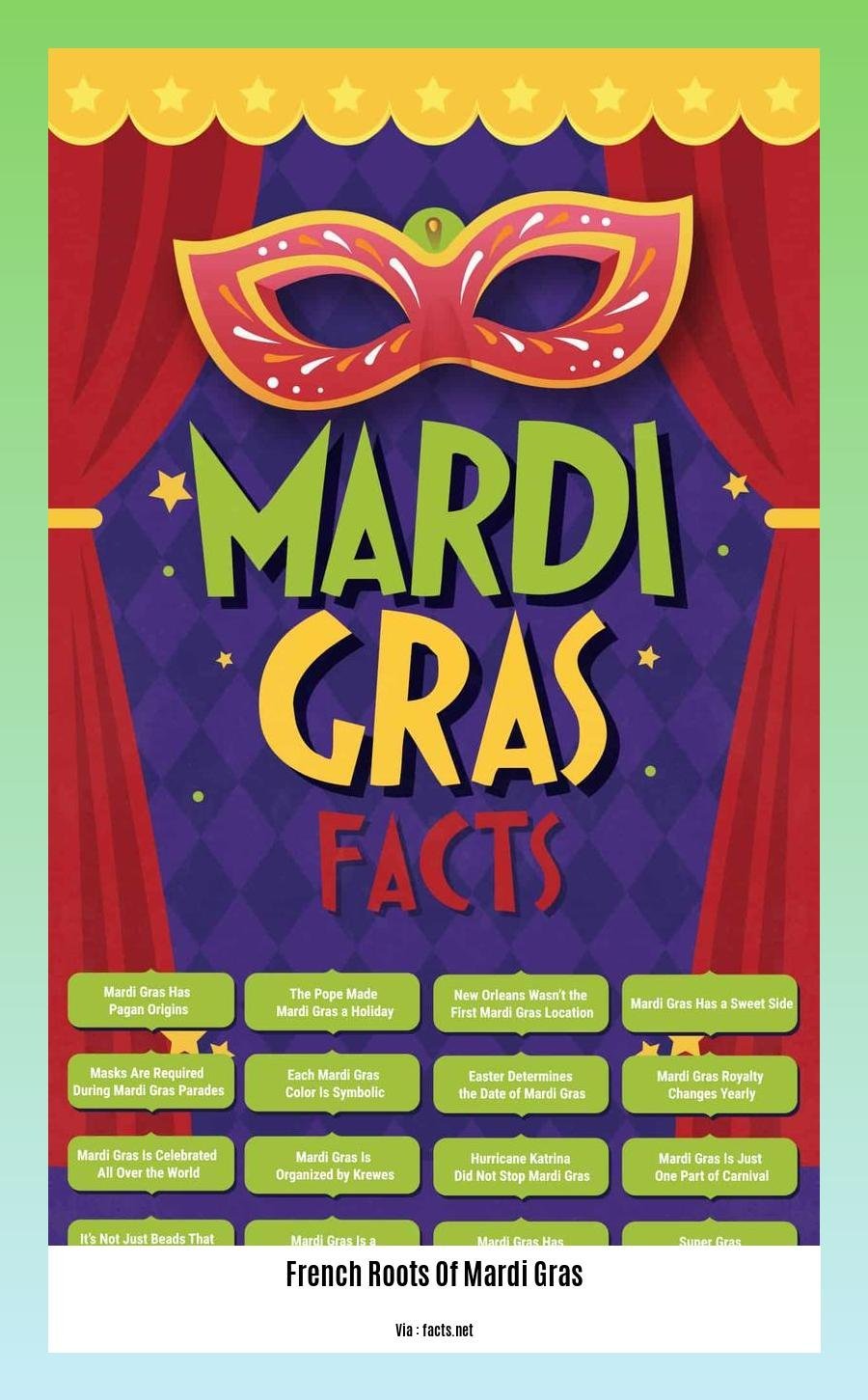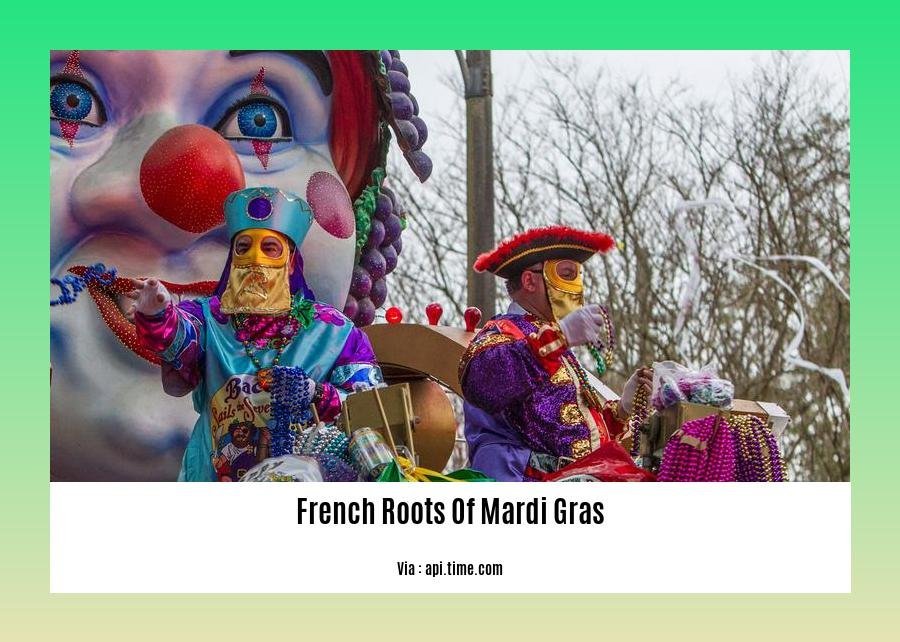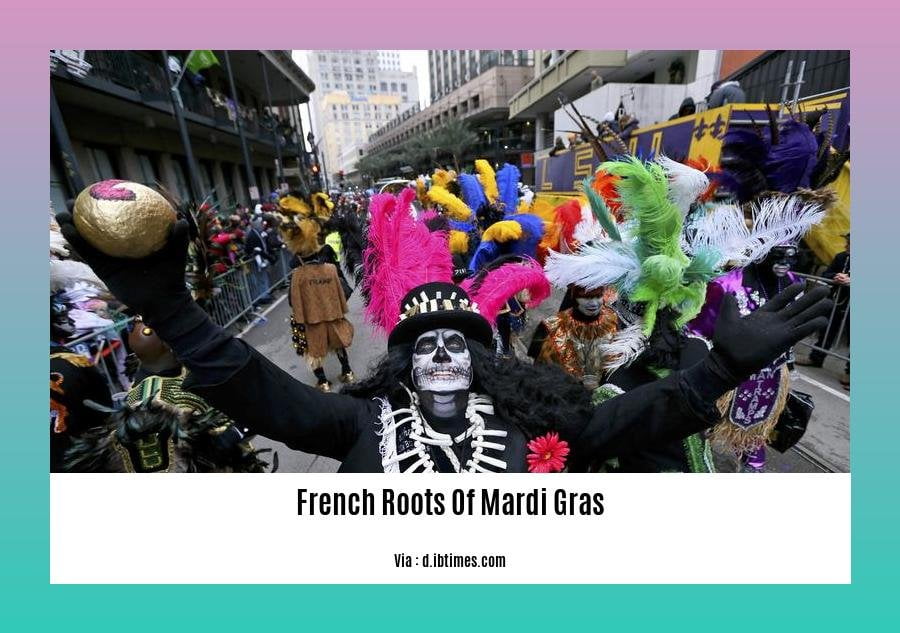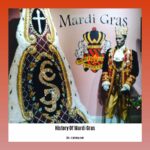Unveiling the French Roots of Mardi Gras: A Cultural Exploration. Peer into the origins of Mardi Gras, a vivacious celebration steeped in French heritage. From its genesis as a pagan festival to its evolution through the Middle Ages, discover the threads of French culture that have woven this vibrant tradition into its present-day grandeur.
Key Takeaways:
- Mardi Gras is a festive day observed in France on the Tuesday before Ash Wednesday.
- It symbolizes the end of the pre-Lenten season, a time of celebration before the fasting and abstinence of Lent.
- The tradition originated in medieval Europe and involved using up all the fats in the home before the fasting period.
French Roots of Mardi Gras

Mardi Gras, a vibrant festival, traces its origins to French roots. Rooted in the medieval period, it marks the culmination of the pre-Lenten season, a time of merriment before the solemnity of Lent. Let’s delve into its fascinating French heritage.
Medieval Origins
Mardi Gras, meaning “Fat Tuesday” in French, originated in the Middle Ages. In France, it marked the last day before the 40-day fasting period of Lent. The tradition emerged from the practice of consuming all the fats in the home to avoid waste before fasting began.
Festive Celebrations
On Mardi Gras, people dressed in colorful costumes and masks, creating an atmosphere of anonymity and revelry. Parades filled the streets, featuring floats, musicians, and performers. The festivities included feasting, dancing, and general merriment.
French Influences
The French roots of Mardi Gras are evident in its customs and symbolism. The tradition of wearing masks, for example, is believed to have originated in the French masquerade balls of the 18th century. The use of beads and trinkets thrown from parade floats symbolizes the abundance of the pre-Lenten season.
End of the Festivities
At midnight on Mardi Gras, the festivities come to an end as Ash Wednesday marks the beginning of Lent. The transition from celebration to penance is symbolic of the cycle of life and the renewal of faith.
Mardi Gras remains a beloved tradition, celebrated with enthusiasm in France and around the world. Its French roots have shaped its unique blend of revelry, cultural expression, and religious symbolism.
Discover the evolution of Mardi Gras, a festival whose origins date back centuries. Dive into the history of Mardi Gras and its vibrant traditions, and explore the iconic Mardi Gras in New Orleans, where the celebration reaches its peak with parades, costumes, and revelry.
Religious Connections and the Catholic Church
Mardi Gras, with its boisterous celebrations, has a deep-rooted connection with the Religious Connections and the Catholic Church. Originally a pagan festival honoring the arrival of spring, it was later adopted by the Church as a way to mark the start of the Lenten season, a time for fasting and reflection.
Despite its Christian influence, Mardi Gras retained many of its pagan elements, such as feasting and merrymaking. On this day, people would indulge in foods that would be forbidden during the 40-day fast that followed. This practice gave rise to the name “Fat Tuesday,” as it allowed for a final indulgence before the period of abstinence.
Over time, Mardi Gras became a significant event in the Catholic calendar. Parades and festivities were organized to commemorate the occasion, often incorporating religious imagery and symbolism. Masks and costumes played a vital role, allowing participants to temporarily escape social norms and embrace anonymity.
The Religious Connections and the Catholic Church to Mardi Gras are undeniable. The festival, with its mix of pagan and Christian elements, reflects the complex history of cultural assimilation and the enduring influence of religious traditions on secular celebrations.
Key Takeaways:
- Mardi Gras was originally a pagan festival adopted by the Catholic Church.
- It became a day for feasting and merrymaking before the start of Lent.
- Mardi Gras celebrations incorporate religious imagery and symbolism.
- Masks and costumes allow participants to embrace anonymity and escape social norms.
Relevant URL Sources:
- Mardi Gras: A French Celebration With Christian Roots
- Mardi Gras – Meaning, Origin & Traditions | HISTORY
Cultural Practices: Masks, Costumes, and Parades

Masks, costumes, and parades are iconic symbols of Mardi Gras, embodying the festival’s vibrant cultural expressions. These practices have deep roots in French traditions, reflecting centuries of merrymaking and social commentary.
Masks:
Masks have played a crucial role in Mardi Gras celebrations since medieval times, providing anonymity and a sense of liberation. Originally worn by upper-class revelers at masquerade balls, the tradition evolved to include intricate masks donning feathers, beads, and symbols representing different societal roles or satirical themes. Today, masks remain a hallmark of Mardi Gras, allowing participants to break free from social norms and engage in playful interactions.
Costumes:
Elaborate costumes are another defining feature of Mardi Gras. The colorful and whimsical outfits reflect the festival’s spirit of joy and extravagance. From shimmering gowns to flamboyant suits, costumes allow participants to transform themselves into characters, animals, or mythical creatures. The eclectic mix of costumes adds to the festive atmosphere and creates a sense of unity among revelers.
Parades:
Parades are the heart and soul of Mardi Gras celebrations, showcasing the festival’s grandeur and creativity. These processions feature elaborate floats adorned with vibrant colors, intricate designs, and larger-than-life characters. Local organizations and krewe (social clubs) spend months planning and constructing their floats, which compete for coveted awards. The parades are a spectacle of sound, color, and spectacle, drawing massive crowds of spectators who eagerly catch beads and trinkets thrown by parade participants.
French Influences:
France’s significant impact on Mardi Gras is evident in these cultural practices. The tradition of wearing masks likely originated from French masquerade balls, while the practice of throwing beads and trinkets symbolizes the abundance and revelry associated with the festival. The parades themselves have been influenced by French military parades, with marching bands and colorful floats reminiscent of French military pageantry.
Key Takeaways:
- Masks, costumes, and parades are central to Mardi Gras celebrations, providing anonymity, liberation, and festive expression.
- Masks have deep roots in French masquerade balls and symbolize social commentary.
- Elaborate costumes allow participants to transform themselves and add to the festival’s atmosphere.
- Parades showcase the grandeur and creativity of Mardi Gras, with floats competing for awards and spectators catching beads and trinkets.
- French influences are evident in the use of masks, the tradition of throwing beads, and the parade format.
Citations:
- Mardi Gras in France: Origins and Traditions
- Mardi Gras History and Traditions | Origin of Mardi Gras
Legacy and Evolution of Mardi Gras Traditions
As we delve into the vibrant world of Mardi Gras, it’s impossible to ignore its deep-rooted connection to French culture. Like a hidden tapestry woven through time, French traditions have left an indelible mark on this beloved festival.
Parades and Costumes: A Legacy of Revelry
The spectacle of Mardi Gras parades is a testament to the French influence. Elaborate floats adorned with intricate designs roll through the streets, accompanied by masked revelers in vibrant costumes. This tradition finds its roots in medieval France, where masquerade balls were all the rage.
The King Cake: A Symbol of Abundance
The tradition of the King Cake is another French legacy. Believed to have originated in the Middle Ages, this sweet treat symbolizes abundance and good luck. Whoever finds the small plastic baby inside is crowned the “king” for the day, an honor bestowed upon our French ancestors during their own Mardi Gras festivities.
Masks and Beads: Echoes of French Festivities
The wearing of masks has been a defining characteristic of Mardi Gras since its inception. In France, masks were worn to allow revelers to break societal norms and indulge in anonymity. Today, this tradition continues, with countless attendees adorning masks to celebrate and liberate themselves.
The Evolution of Mardi Gras Traditions
Over centuries, Mardi Gras traditions have evolved while maintaining their French roots. Parades have grown more elaborate, costumes more imaginative, and the festival’s reach has spread across the globe. Yet, the spirit of celebration, camaraderie, and indulgence remains as a testament to its French heritage.
Key Takeaways:
- Mardi Gras parades and costumes showcase the influence of French masquerade balls.
- The King Cake symbolizes abundance and is a relic of French medieval traditions.
- Masks and beads have evolved from French festivities, allowing revelers to embrace anonymity and liberation.
- Mardi Gras traditions have evolved while maintaining their French roots, reflecting the festival’s legacy and cultural heritage.
Relevant URL Sources:
















